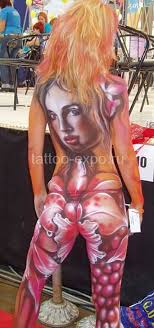Tattoos are created by inserting colored materials beneath the skins surface for decorative or other reasons. Many people use tattoos as a type of decorative modification. Many different cultures use tattoos for different purposes such as status or religion. Tattoos on animals are most commonly used for identification purposes. Whatever the reason behind it, people have been making tattoos for over 5000 years. The word tattoo comes from the Tahitian word tattau, which means "to mark". Tattooing was rediscovered by Europeans when exploration brought them into contact with American Indians and Polynesians.
A wide variety of tattooing methods developed in different cultures. Many Indian tribes routinely tattooed the body of the face by simple pricking and some tribes in California introduced color into scratches. Actual needle punctures were used in eastern Siberia which made needle punctures through a thread coated with pigment, usually soot, and drawn underneath the skin. The people of New Zealand applied there wood carving techniques to tattooing. In Micronesia and Polynesia, pigment was pricked into the skin by tapping on a tool shaped like a small rake.
Ritual and tradition have been common and constant factors in tattooing. In some societies, as when family crests or tribal symbols were used, tattoos helped identify bands of people. During the Victorian era, the modern tattoo machine was fist invented and patented. That design is pretty much the same today. In Borneo, women bore a symbol on their arms to denote their specific skills, thus increasing their potential for marriage. Tattoos worn around the fingers and wrists were said to ward off illness. In other societies, criminals were marked so others would clearly know who they are. For some, the purpose of tattoos was generally centered on becoming more in tune with nature or the divine, or was believed to bestow the wearer magical abilities and blessings as well as ward off demons or even bring about better health.
For a brief time in the early 1700s, tattooing, which was a costly and lengthy procedure, became a status symbol and only the wealthy could afford to have it done. All of that changed with the invention of the first electric tattoo needle in 1891. Then, everyone who wanted a tattoo could have one which resulted in them being considered vulgar. After all of that, tattoo art went "underground". Tattoos finally became desirable once again after designs and safety techniques improved and several celebrities began sporting them.
If anything, the history of tattooing shows us the mindset of our ancestors and what was important at that time. The nature of tattooing is now more cosmetic rather that ritualistic, showing individuality and the use of the body as a canvas for art. As for the future of tattooing, we will just have to wait and see.
By Misty Stacy

No comments:
Post a Comment